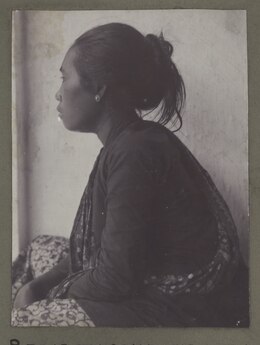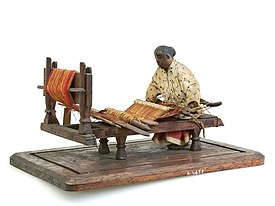| Orèng Bawean | |
|---|---|
 The portrait of native Bawean woman from side-angle . The portrait of native Bawean woman from side-angle . | |
| Regions with significant populations | |
| Languages | |
| |
| Religion | |
| Related ethnic groups | |

The Bawean, or Baweans, or also Baweanese, also called Bawean Madurese (Madurese: Ḅâbean, Ḅâbian, or Ḅâbinian) are an ethnic group native to the island of Bawean, located in the Java Sea off the coast of Java, Indonesia. They are considered a distinct ethnic group within the larger Javanese cultural sphere. The Bawean people have their own unique language, also called Bawean, which belongs to the Austronesian language family.
Historically the Bawean Island was a trading post and a hub for maritime activities, which brought influences from various cultures such as Javanese, Madurese, Banjarese, Makassarese, Chinese, and Arab. As a result, the Bawean people have a rich cultural heritage that blends elements from these diverse influences.
Most Bawean people are Muslims, and Islamic traditions and values play a significant role in their daily lives. They have a close-knit community structure and maintain strong cultural and social ties. Traditionally, the Bawean people have been involved in various occupations, including agriculture, fishing, and maritime trade.
Migration also plays a significant role in the history and present-day dynamics of the Bawean people. Due to various factors, including economic opportunities, trade networks, and colonial influences, the Bawean people have engaged in migration both within Indonesia and to other countries. They traveled to different parts of the Indonesian archipelago and even ventured further to neighboring countries like Malaysia and Singapore for trade and economic purposes. In the latter two countries, they are known as Boyan (originally an English mispronunciation of Bawean, but now generally used, including as self-designation of the local Bawean community). These maritime connections allowed them to establish communities and settlements in different regions.
History

Although the Baweans are originally belongs to the Madurese group in general, however, the Baweans are also officially classified and recognized as a distinct ethnic group by the Indonesian Government due to their multiple inter-connected historical lineage backgrounds; for instance, common intermarriage phenomenon with the Javanese, an ethnic group originally from the Java Island located in southern Bawean Islands (blooming intensively since the conquest of Majapahit era over Bawean until present-day). The official Indonesian dictionary defines the Baweans as "mixed people of Javanese, Madurese, Banjar, Bugis, and Makassar which occurred since hundreds of years ago".
Distribution


The homeland of the Bawean people is the Bawean Islands in the Java Sea. As a result of migration, nowadays the Baweans can be found in all regions across Indonesia, especially in western Indonesian region. Some small population (which mostly considered or viewed as ethnic minority group) of Baweans also can be found in several countries across Southeast Asia and Oceania, such as in Singapore, Australia, Vietnam, Malaysia, etc.
Culture

As part of the wider Javanese cultural sphere, the culture possessed by the Baweans shared quite similar cultural traits to those Javanese people in general. The arts and crafts of Baweans generally are following those in Java, such as the Batik-making culture, the martial art of Pencak and Silat, the prominent usage of Kris dagger, etc. However, the Baweans also quite well-known for their ꦠꦶꦏꦂ (Tikar, lit. 'plaited mat') handicraft tradition adorned with intricate Bawean's cultural patterns which symbolize their ethnic identity; these cultural practice is officially recognized by Indonesian government as integral part of national's Intangible Cultural Heritage.
Cultural architecture
Dhurung
Main article: Dhurung
Dhurung is one of the traditional architectures of the Baweans usually built on the side or in front of the traditional Bawean house, it is not much different to their ancestors architectures, namely the Pendhapa of Javanese. The Dhurung commonly functioned as the outdoor meeting point to welcome the non-formal guests (traditionally speaking, non-formal guests means the guests that came only for having a casual talks, not the one who are going to make important deals or agreements), apart from that, the Dhurung also traditionally functioned as the barn to store the harvested rice or another crops.
Cultural clothing
Main articles: Batik, Kebaya, Sarong, and Tenun
Following their ancestors whose originally came from Java and Madura islands, the Baweans usually wore the cultural clothing tradition of ultimate Javanese origin, which may include the prominent usage of Kebaya for women as well as the Batik loincloth (sarong) for both gender, some Majapahit naval flag's derived clothing may also apparent on the island which exhibits their Madurese and Eastern Javanese kinship. One of the popular Batik-making traditions possessed by the Baweans is called the Batik Penaber (lit. 'Penaber Batik' (in English)), characterized by its prominent depiction of Bawean's cultural motifs. Administratively part of Gresik in mainland Java, some Bawean islanders in Bawean Islands also preserved the Tenun Gresik tradition, which is part of the larger Tenun (Indonesian for 'woven fabric') uniquely native to Gresik.
Language
Main article: Bawean MadureseAccording to anthropological and linguistic studies, the Baweans speak the Bawean Madurese, a western dialect of Madurese language closely related to the Bangkalan Madurese spoken natively in Bangkalan (Madura Island) with >80% to 94% dialectical similarity. Part of Javanic languages family, some Javanese (especially through Old Javanese) linguistic elements also apparent within the Bawean Madurese (as well as Madurese in general). However, the Baweans in some villages still preserve their spoken language in full Javanese, such as in the Diponggo village. These language variety is traditionally written in both Javanese (following the Javanese script of Standard Madurese) and Pegon (Java-Arabic) scripts, but nowadays it has gradually written using the Latin script as well (following the Standard Madurese romanization).
Livelihood

The Baweans traditionally are fishermen, farmers, gardeners, craftsmen, Tenun weavers, and some of them succeed as businessmen. Descended from Javanese and Madurese sailors, back in ancient times, the Baweans also recorded as one of notable 'maritime people' who were socially active dealing with foreign (non-native Indonesians) traders such as with the Arabs, Indians, Chinese, etc and even regarded as one of the 'maritime axis' people of Indonesia; these can be examined through some archaeological findings in Bawean Island, from ancient harbours sites to the Arabic-carved gravestones which dates back to pre-Islamic era.
Religions and beliefs

Most of modern-day Baweans are Muslims (the followers of Islam), predominantly adhered to Sunni of Nahdlatul Ulama (Native Indonesian Muslim's religious sect organization). Some religious-based festive traditions also possessed by the Baweans, such as the Molod to commemorate the birthday of Muhammad, etc.
References
- ^ "Bahasa Madura" [Madurese Language], Badan Pengembangan dan Pembinaan Bahasa (in Indonesian), Ministry of Education and Culture of the Republic Indonesia
- ^ "Bahasa yang Digunakan di Pulau Bawean" [Language Spoken in Bawean Island], Language Development Agency of the Republic Indonesia (in Indonesian), National Data on Language and Literatures (of the Republic Indonesia), 1997
- Hidayah, Dr Zulyani (2015). Ensiklopedi Suku Bangsa di Indonesia (in Indonesian). Yayasan Pustaka Obor Indonesia. ISBN 978-979-461-929-2.
- M. F. Aziri; A. Wahyudi (2019). "Become Boyan: The Arrival and Development of Baweanese in Singapore in the 19–20th Century". Journal of Maritime Studies and National Integration. 3 (2): 54–61. doi:10.14710/jmsni.v3i2.6082. S2CID 213376374.
- "Mengenal Suku Bawean yang Suka Merantau" (in Indonesian). kompas. 2015.
- Raffles, Sir Thomas Stamford (1830). The History of Java. Vol. 1. J. Murray.
- "Bawean" [Search "Bawean" on Indonesian Dictionary]. Great Dictionary of Indonesian (Online) (in Indonesian).
- Malte Stokhof, Oscar Salemink (2009), "State Classification and Its Discontents: The Struggle Over Bawean Ethnic Identity in Vietnam", Journal of Vietnamese Studies, 4 (2), University of California Press: 154–195, doi:10.1525/vs.2009.4.2.154
- "Kerajinan Tikar Bawean" [The Bawean's Cultural Handicraft: Tikar], Intangible Cultural Heritage of Indonesia (in Indonesian), Ministry of Education and Culture of the Republic Indonesia, 2019
- ^ Balai Pelestarian Nilai Budaya D.I. Yogyakarta . "Dhurung: Arsitektur Tradisional Khas Pulau Bawean" [Dhurung: Typical Traditional Architecture of Bawean Island]. Directorate General of Culture (in Indonesian). Ministry of Education and Culture of the Republic of Indonesia.
- Miftahul Faiz (2021). "Bawa Motif Khas Bawean, Batik Penaber Bawean Ikuti Pameran Indonesia Product Expo (Inapro Expo) 2021" [Conserve The Bawean Motifs, Bawean's Penaber Batik Participates in the 2021 Indonesia Product Expo Exhibition (Inapro Expo)]. klikjatim.com (in Indonesian). KlikJatim.
- Integrasi Kata Bahasa Jawa dan Bahasa Madura Ke Dalam Dialek Bawean [Javanese and Madurese Linguistic Integration in the Spoken Language of Bawean (Bawean Madurese)] (in Indonesian), vol. 7, 2020
- ^ "Peran Pulau Bawean Dalam Poros Maritim Nusantara" [The Role of Bawean in the Maritime Axis of the Indonesian Archipelago]. Balai Arkeologi Yogyakarta (in Indonesian). Ministry of Education and Culture of the Republic of Indonesia. 2018.
- Sri Wiryanti Budi Utami, Bea Anggraini (2019), 'Islamic' Bawean Cultural Identity in Tradition, European Union Digital Library, doi:10.4108/eai.20-9-2019.2296726, ISBN 978-1-63190-255-0, S2CID 220127292
- "Molod Bawean" [Molod, the tradition of Baweans], Intangible Cultural Heritage of Indonesia (in Indonesian), Ministry of Education and Culture of the Republic Indonesia, 2019
Notes
- The Javanese script used for Madurese is slightly different to the Javanese script used for Standard Javanese
Bibliography
- I. Farjon (1980), Madura And Surrounding Islands: An Annotated Bibliography, 1860–1942, Volumes 9–13, M. Nijhoff, ISBN 978-902-472-4109
See also
- Bawean – the native island of the Baweans
- Bawean deer – an endemic deer native to Bawean Island
- Bawean Airport – an airport in Bawean Island
Further reading
| Ethnic groups in Indonesia | |
|---|---|
| Indonesians | |
| Sumatra | |
| Java | |
| Kalimantan | |
| Sulawesi | |
| Papua | |
| Lesser Sunda Islands | |
| Maluku Islands | |
| Non-indigenous | |